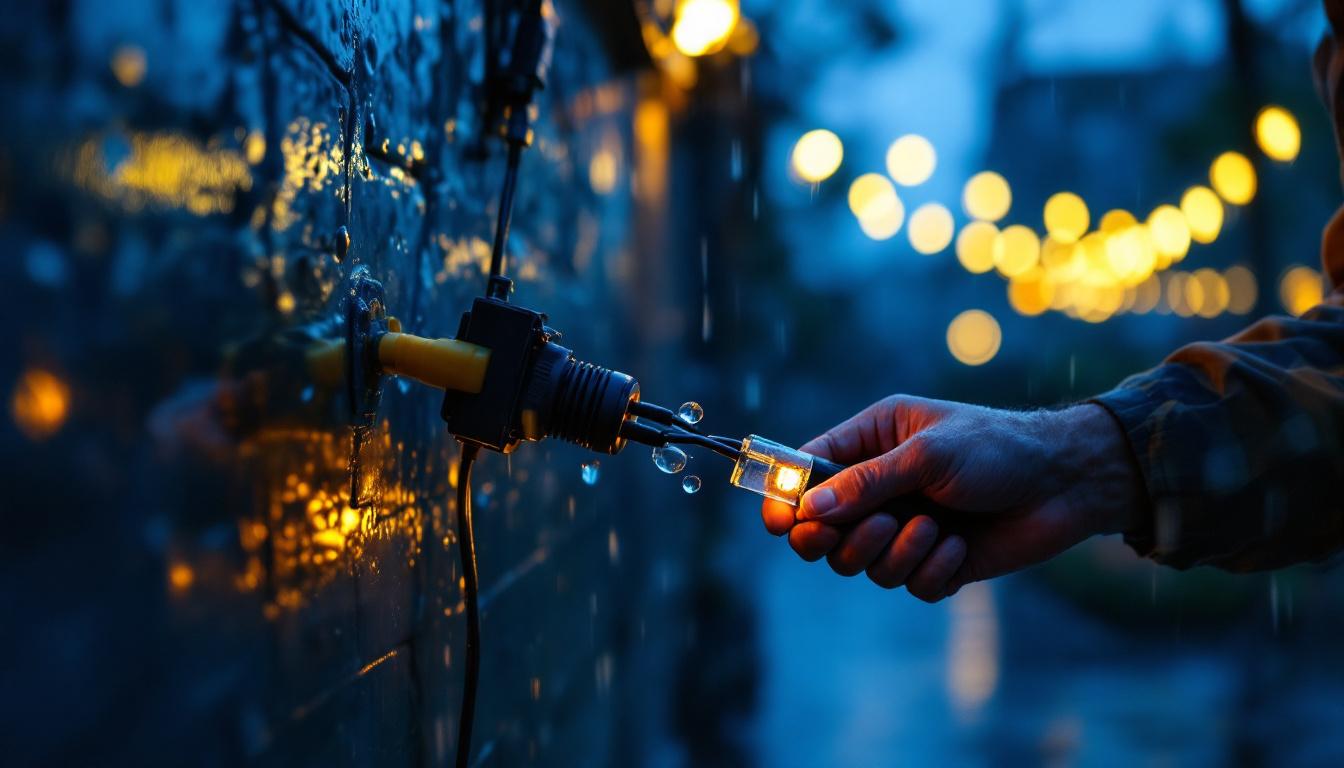
Lighting contractors are constantly on the lookout for innovative solutions that enhance their projects while also being environmentally friendly. One such solution that has gained traction in recent years is solar-powered LED strip lights for outdoor use. These versatile lighting options not only provide illumination but also contribute to energy savings and sustainability. This article delves into the secrets of mastering solar-powered LED strip lights, offering insights that can elevate any lighting project.
Solar-powered LED strip lights are flexible lighting solutions that harness solar energy to illuminate outdoor spaces. They come equipped with solar panels that charge during the day, allowing the lights to operate at night without relying on traditional electricity sources. This feature makes them particularly appealing for outdoor applications, where access to power outlets may be limited.
The core functionality of solar-powered LED strip lights revolves around their solar panels, which convert sunlight into electrical energy. During daylight hours, the panels absorb sunlight and convert it into a charge that is stored in built-in batteries. As the sun sets, the stored energy powers the LED lights, providing illumination throughout the night.
Most models come with built-in sensors that automatically turn the lights on at dusk and off at dawn, ensuring hassle-free operation. This automation not only enhances user convenience but also optimizes energy consumption, making these lights an eco-friendly choice. Some advanced models even feature adjustable brightness settings, allowing users to customize the light output based on their specific needs or preferences, which can be particularly useful for creating different atmospheres in outdoor spaces.
One of the most significant advantages of solar-powered LED strip lights is their energy efficiency. By utilizing renewable energy, they reduce reliance on fossil fuels and lower electricity bills. Additionally, LED technology itself is known for its longevity and low power consumption, further enhancing the overall efficiency of these lighting solutions.
Moreover, solar-powered lights are incredibly versatile. They can be used for a variety of applications, including pathway lighting, garden illumination, and even decorative purposes for events. Their flexibility allows contractors to incorporate them into different designs and layouts, catering to the specific needs of clients. For instance, they can be creatively arranged along fences, patios, or even around trees to create enchanting lighting effects that enhance the aesthetic appeal of outdoor environments.
In addition to their aesthetic and functional benefits, solar-powered LED strip lights contribute to sustainability efforts. By reducing energy consumption and utilizing a renewable energy source, they play a role in decreasing carbon footprints. Many manufacturers are now focusing on producing these lights with environmentally friendly materials, further ensuring that their production and disposal have minimal impact on the planet. This commitment to sustainability resonates with eco-conscious consumers, making solar-powered LED strip lights not just a practical choice, but also a responsible one.
Selecting the appropriate solar-powered LED strip lights for a project involves several considerations. Contractors must assess factors such as brightness, length, battery capacity, and weather resistance to ensure optimal performance.
When it comes to outdoor lighting, brightness is a crucial factor. The brightness of LED lights is measured in lumens, and the right amount will depend on the intended use of the lights. For instance, pathway lighting may require fewer lumens compared to lighting a larger outdoor area like a patio or garden. Understanding the specific requirements of each project will guide contractors in selecting the right lumens for their solar-powered LED strip lights. It’s also important to consider the color temperature of the lights, as this can influence the ambiance of the space. Warmer tones can create a cozy atmosphere, while cooler tones may enhance visibility and security in darker areas.
Solar-powered LED strip lights come in various lengths, allowing for customization according to the layout of the area to be illuminated. Contractors should consider the flexibility of the strips as well; some models are designed to be cut to size, enabling precise installation in unique spaces. This adaptability ensures that the lights can fit seamlessly into any design, enhancing both functionality and aesthetics. Furthermore, the ability to bend and shape the strips means they can be used in creative applications, such as outlining architectural features or creating dynamic lighting effects in outdoor entertainment areas. This versatility not only enhances the visual appeal but also allows for innovative lighting solutions tailored to specific needs.
The battery capacity of solar-powered LED strip lights directly affects their performance. A higher capacity means longer illumination times, which is essential for areas that require extended lighting. Additionally, contractors should evaluate the charging time of the batteries. Ideally, lights should fully charge within a reasonable period to ensure consistent performance, especially in regions with varying sunlight availability. It’s also beneficial to look for models equipped with smart technology that can adjust brightness based on the time of day or ambient light levels, maximizing energy efficiency. This not only prolongs the lifespan of the battery but also ensures that the lights are always operating at their optimal level, providing reliable illumination when it’s needed most.
Proper installation is key to maximizing the effectiveness of solar-powered LED strip lights. Following best practices can lead to enhanced performance and longevity of the lighting system.
The placement of solar panels is critical for ensuring maximum exposure to sunlight. Contractors should install the panels in locations that receive direct sunlight for most of the day, avoiding shaded areas caused by trees, buildings, or other structures. This strategic positioning will enhance the charging efficiency and, consequently, the performance of the LED lights.
For outdoor applications, securing the LED strip lights properly is essential to withstand environmental conditions. Using weather-resistant mounting options can protect the lights from wind, rain, and other elements. Additionally, ensuring that the strips are installed at appropriate heights can prevent accidental damage and enhance safety.
Dust, dirt, and debris can accumulate on solar panels, reducing their efficiency. Regularly cleaning the panels with a soft cloth or sponge can help maintain their ability to absorb sunlight effectively. This simple maintenance task can lead to improved charging times and overall performance.
Periodic inspections of the connections and components of the solar-powered LED strip lights are essential. Checking for any signs of wear, corrosion, or damage can help identify potential issues before they escalate. Ensuring that all connections are secure will also prevent power loss and enhance the reliability of the lighting system.
While solar-powered LED strip lights offer numerous benefits, they are not without challenges. Understanding these challenges and knowing how to address them can help contractors provide better solutions for their clients.
In regions with limited sunlight or during winter months, solar-powered lights may struggle to charge adequately. To combat this, contractors can recommend models with larger solar panels or higher battery capacities. Additionally, installing lights in areas that receive the most sunlight can help mitigate this issue.
Inconsistent performance can arise from various factors, including poor installation or inadequate charging. Contractors should ensure that the solar panels are optimally positioned and that the lights are installed securely. Educating clients about the importance of maintaining the solar panels can also help improve performance over time.
Beyond traditional uses, solar-powered LED strip lights can be creatively integrated into various projects, offering unique solutions for lighting challenges.
Solar-powered LED strip lights can add a magical touch to outdoor events such as weddings, parties, and festivals. Their flexibility allows for creative designs, such as wrapping them around trees, draping them along fences, or outlining pathways. This versatility not only enhances the ambiance but also eliminates the need for cumbersome extension cords and generators.
Incorporating solar-powered LED strip lights into security lighting systems can enhance safety in residential and commercial properties. By strategically placing the lights around entrances, pathways, and dark corners, contractors can provide effective illumination that deters potential intruders while ensuring visibility for occupants.
The future of solar-powered LED strip lights looks promising, with ongoing advancements in technology and design. As energy efficiency becomes increasingly important, these lighting solutions are expected to evolve, offering even more features and benefits.
As smart home technology continues to gain popularity, solar-powered LED strip lights are likely to integrate with smart systems. This could allow users to control their lighting remotely, set schedules, and even monitor energy usage through mobile applications. Such advancements would enhance user convenience and further promote energy efficiency.
Future developments in battery technology could lead to longer-lasting and more efficient batteries for solar-powered LED strip lights. Enhanced battery performance would ensure that lights can operate effectively even in less-than-ideal weather conditions, making them a more reliable option for outdoor lighting.
Solar-powered LED strip lights represent a significant advancement in outdoor lighting solutions, offering contractors an eco-friendly, versatile, and cost-effective option for their projects. By understanding the intricacies of these lights, from selection and installation to maintenance and innovative applications, lighting contractors can master this technology and provide exceptional value to their clients.
As the demand for sustainable solutions continues to grow, embracing solar-powered LED strip lights will not only enhance project offerings but also contribute to a greener future. By staying informed about the latest trends and technologies, lighting contractors can position themselves as leaders in the industry, ready to meet the evolving needs of their clients.
Ready to elevate your lighting projects with solar-powered LED strip lights? At LumenWholesale, we provide lighting contractors with the highest quality, spec-grade lighting products at unbeatable wholesale prices. Say goodbye to local distributor markups and hello to superior lighting solutions that meet the highest industry standards. With our hassle-free bulk buying and free shipping, you can trust that you’re getting premium lighting at the best value — without hidden fees or compromises. Enhance your outdoor lighting projects today and contribute to a more sustainable future. Visit LumenWholesale for Wholesale Lighting at the Best Value.

Discover why lighting contractors should prioritize wall sconce lighting indoors.

Discover the latest trends in direct wire under cabinet lighting that every lighting contractor needs to know.

Discover the essentials of solar-powered garden lights and compliance standards that every lighting contractor should know.

Discover essential tips for lighting contractors on choosing and using low voltage waterproof wire connectors to prevent common installation issues.